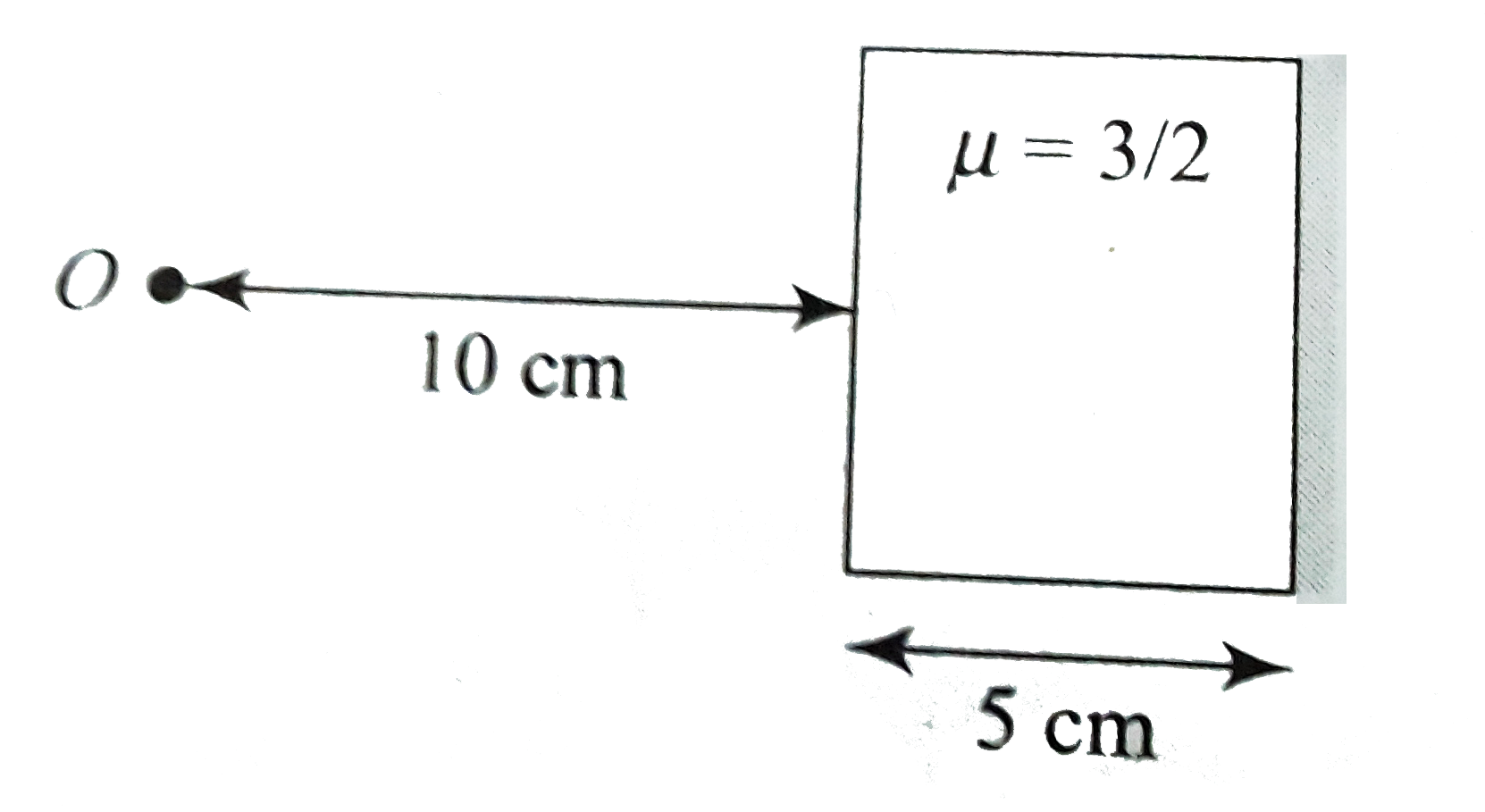A glass hemispher of refractive index 4/3 and of radius 4cm is placed on a plane mirror. A point object is placed on axis of this sphere at a distance 'd' from O as shown in the figure. If the final image is formed at infinity, then find the value of d in mm .

The correct Answer is:30
The image of object O by refraction at plane surface is formed at I such that
AI=43d

I acts object for curved surved. The curved surface makes image of I at I
1v−43−(R+43d)=1−43−Ror1v=13R−43R+4d
I' acts as object for mirror. Mirror makes its image at I" distance v above B .
I" acts as virtual object for the curved surface which makes its image at infinity
43∞−[13R−43R+4d]=13R
Solving we get d=34R34×4=3cm
Topper's Solved these Questions
- BOOK - RESONANCE ENGLISHCHAPTER - GEOMATRICAL OPTICS EXERCISE - Exercise-380videos
GEOMATRICAL OPTICS
- BOOK - RESONANCE ENGLISHCHAPTER - GEOMATRICAL OPTICS EXERCISE - Advance level Problems35videos
GEOMATRICAL OPTICS
- BOOK - RESONANCE ENGLISHCHAPTER - GEOMATRICAL OPTICS EXERCISE - Exercise-1141videos
GEOMATRICAL OPTICS
- BOOK - RESONANCE ENGLISHCHAPTER - EXPERIMENTAL PHYSICSEXERCISE - PART -II10videos
EXPERIMENTAL PHYSICS
- BOOK - RESONANCE ENGLISHCHAPTER - GRAVITATIONEXERCISE - HIGH LEVEL PROBLEMS16videos
GRAVITATION
Similar Questions
A thin convex lens of focal length 30cm is placed in front of a plane mirror. An object is placed at a distance x from the lens (not in between lens and mirror ) so that its final image coincides with itself. Then, the value of x is
View SolutionA point is placed in front of thick plane mirror as shown in figure. Find the location of final image w.r.t. object.
 View Solution
View SolutionA point object is placed in fron of two plane mirrors as shown in figure.

Total number of images formed if 'theta=90^(@)?View SolutionFind the distance of object placed in the slab of refractive index μ from point P of the curved surface of radius R so that image is formed at infinity:
 View Solution
View SolutionA convex lens of focal length f and a plane mirror are y distance apart. An object O is kept on the principal axis of the lens at a distance x from the lens. The values of x and y for the final image of O to fall exactly (position and size) on the object O are :
 View Solution
View SolutionA concave mirror of focal length 2cm is placed on a glass slab as shown in the figure. The image of point object O formed due to reflection at mirror and then refraction by the slab
 View Solution
View SolutionAn object is placed at a distance of 30 cm from a concave mirror and its real image is formed at a distance of 30 cm from the mirror. The focal length of the mirror is
View SolutionThe figure shows an arrangement of an equi-convex lens and a concave mirror. A point object O is placed on the principal axis at a distance 40cm from the lens such that the final image is also formed at the position of the object. If the radius of curvature of the concave mirror is 80cm, find the distance d. Also draw the ray diagram. The focal length of the lens in air is 20cm.
 View Solution
View SolutionA thin biconvex lens of refractive index 3/2 and radius of curvature 50cm is placed on a reflecting convex surface of radius of curvature 100cm. A point object is placed on the principal axis of the system such that its final image coincides with itself. Now, few drops of a transparent liquid is placed between the mirror and lens such that final image of the object is at infinity. Find refractive index of the liquid used. Also, find the position of the object.
View SolutionA solid glass sphere with radius R and an index of refraction 1.5 is silvered over one hemisphere. A small object is located on the axis of the sphere at a distance 2R to the left of the vertex of the unsilvered hemisphere. Find the position of final image after all refractions and reflection have taken place.
View Solution
